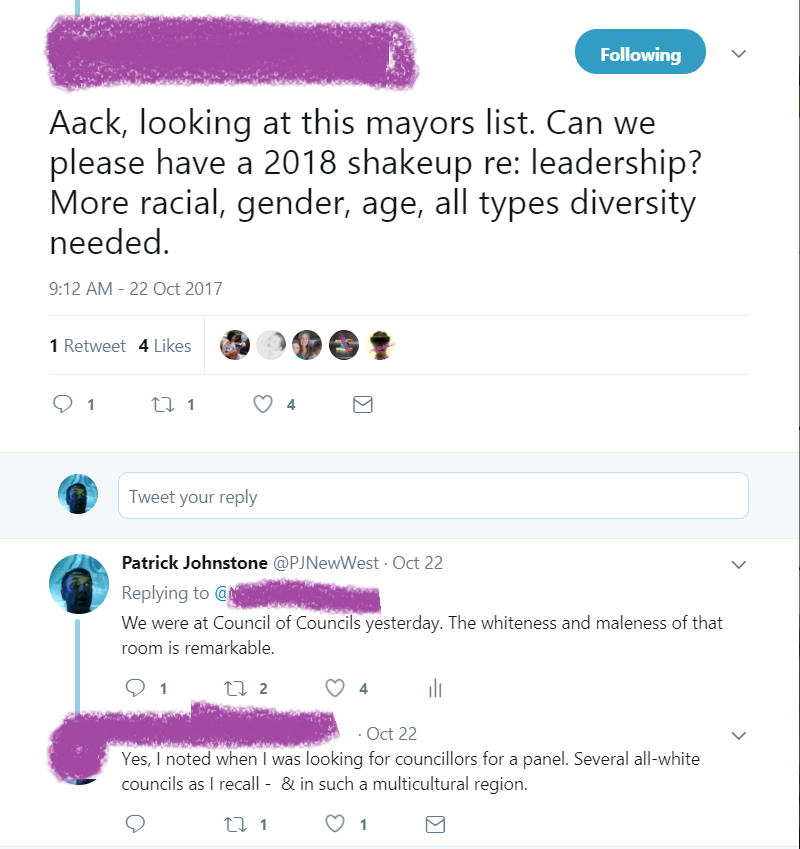On Saturday, local government elected types met in North Vancouver for a Council of Council meeting. For a great write-up of what the meeting is and what we discussed, surf over to Nathan Pachal’s great South Fraser blog. I want to talk about another conversation that came out of the CofC.
At the event, Councillor Trentadue leaned over to me and made the observation (I paraphrase) “Crazy how little diversity there is in this room”. This lack of diversity was also noticed by others covering the event, noted in a few tweets:

I had an afternoon meeting for the Lower Mainland LGA, and side-bar conversations with a few of the Councillors continued on this theme, partly because some members of LMLGA are working on an event to discuss the general lack of “civility” in civic politics, and how that creates barriers to full participation. The story of Mayor Read of Maple Ridge announcing she will not stand for a second term was also fresh in our minds. It would be puerile to assume these issues are not interconnected.
But it go us to talking about the why. Is it the electorate not voting for diversity, or is there something structural in the job that prevents diversity? That seems like something that should be easy to figure out.
I quickly went to the CivicInfo 2014 election results database to ask the question – do we not vote for women, or are women not running? Of the 19 local governments in Greater Vancouver that report on the (binary, natch) gender of candidates (Vancouver and Bowen Island do not provide this data) for Mayor and Council, the data gives us this:
 For Council, 33% of candidates were women, and 38% of those elected were women.
For Council, 33% of candidates were women, and 38% of those elected were women.
 For Mayor, 16% of candidates were women, and 16% of the winners were women. Perhaps more tellingly, there was a woman on the mayoral ballot in only 7 of 19 communities (three were elected).
For Mayor, 16% of candidates were women, and 16% of the winners were women. Perhaps more tellingly, there was a woman on the mayoral ballot in only 7 of 19 communities (three were elected).
As a first-level approximation, we can suggest that voters, when given the opportunity, vote for women at least as commonly as for men. However, there are half as many women running for Council, and a paltry one-in-six mayoral candidates are women. If it isn’t the voter’s fault that local government is so dominated by men, what is it about the job that so biases those who apply for the job? I have my own suspicions, but maybe I’m not the right person to answer that question?
Unfortunately, there is absolutely no data collected on whether candidates identify as persons of colour, members of a First Nation, or have disabilities. It is harder to tell if it is the voters that account for the shade of the average Council of Council room.
I should note that it was pointed out to me recently (through a letter to Mayor and Council) that there is a general a lack of diversity in our Council Advisory Committees, and that the City does not appear to be taking any specific actions towards increasing that diversity (hey, apply for a committee now!). It is also recognized that the current Public Consultation and Public Hearing model is dominated by, well, the dominant demographic. I don’t have the answers here, but strongly feel we need to broaden public participation at the community level first if we are going to see more diversity in elected roles. Unless we do, it is hard to call our society “democratic”.
Hi Pat, I’ve been concerned about diversity in New West politics for quite some time. The inconvenient truth is New West the oldest city in the province has never elected a member of a visible minority to Council or the Mayor’s chair. I have confirmed this with historians Archie and Dale Miller. In the 20yrs. plus I have lived in New West I have felt it to be an open and tolerant city in which to live. The next civic election is not till 2019 perhaps now would be a good time to initiate a conversation that is respectful and recognizes the sensitive nature of the subject matter. I believe this a glass ceiling that is long overdue to be shattered..
Two quick notes:
The next civic election is 2018! And based on sudden increased interest in social media, I suggest campaigns are already starting.
New West representation has indeed been lily-white. But it wasn’t that long ago the City had a female majority on Council with a woman serving as mayor. Alas, the fact that is an anomaly probaby points more to the problem than any solution.